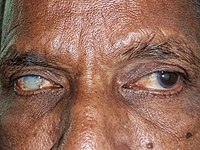
Photo from wikipedia
Cystinosis is a rare lysosomal storage disease with a prevalence of 1 : 100 000 - 1 : 200 000 cases. It is caused by biallelic mutations in the CTNS gene, which encodes cystinosin, that transport cystine out… Click to show full abstract
Cystinosis is a rare lysosomal storage disease with a prevalence of 1 : 100 000 - 1 : 200 000 cases. It is caused by biallelic mutations in the CTNS gene, which encodes cystinosin, that transport cystine out of the lysosomes. Due to its dysfunction, cystine crystals accumulate in the lysosomes and ultimately cause apoptosis of the cell. Since cystinosin is ubiquitously present in the body, cystine crystals are deposited in every body structure and lead to the dysfunction of various organ systems in the course of time. Cystine crystals deposited in the cornea are a clinical hallmark of the disease, while there is less awareness of concomitant posterior segment alterations. Symmetrical pigment epithelial mottling and patches of depigmentation frequently start in the periphery and progress towards the posterior pole and can be encountered upon fundus biomicroscopy. Spectral-domain optical coherence tomography (SD-OCT) is an elegant tool for visualizing chorioretinal cystine crystals at the posterior pole. An SD-OCT-based clinical grading of the severity of the chorioretinal manifestation can potentially be applied as a biomarker for systemic disease status and for monitoring oral therapy adherence in the future. Along with previous histological examinations, it may also give information about the location of cystine crystals in the choroid and retina. This review aims to increase the awareness of vision-threatening retinal and choroidal changes in cystinosis and the concomitant findings in SD-OCT.
Journal Title: Klinische Monatsblatter fur Augenheilkunde
Year Published: 2023
Link to full text (if available)
Share on Social Media: Sign Up to like & get
recommendations!